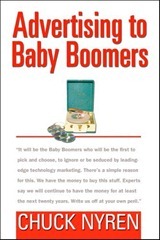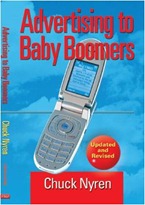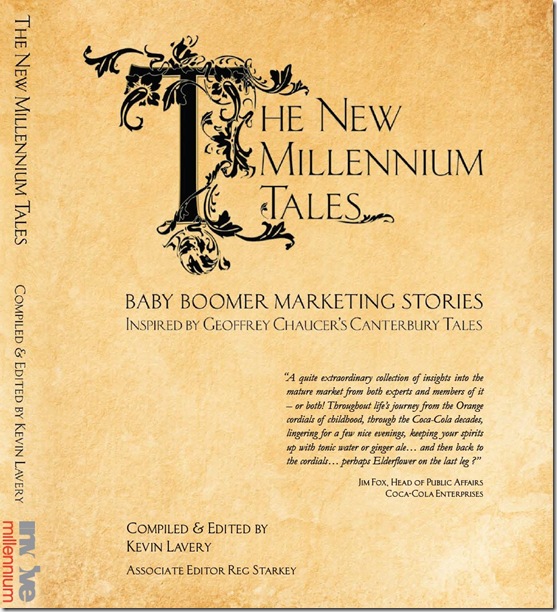From 2008:
AARP's Chicken Coop Coup?
I've picked on AARP's advertising and marketing through the years. I think they can handle it. They're big boys and girls.
For years AARP has been promoting their magazine and other outlets to media planners and advertisers. The first time I ran across one of these efforts was in 2004-5, and wrote about it in my book:
 … The advertising campaign has one ad with ashen-faced Baby Boomers in body bags ("These days, doctors don't pronounce you dead. Marketers do."). Another shows Baby Boomers acting like testosteroned teenagers ("Outta the way, punks: older racers are the hot-rod kings!"). Yet another has one of a middle-aged lady dead in a powder room (probably from overdoing it on the dance floor) with police chalk outlining her body. I don't know what the copy is because I haven't seen it. It's probably something like, "Give me wrinkle cream, or give me death!"
… The advertising campaign has one ad with ashen-faced Baby Boomers in body bags ("These days, doctors don't pronounce you dead. Marketers do."). Another shows Baby Boomers acting like testosteroned teenagers ("Outta the way, punks: older racers are the hot-rod kings!"). Yet another has one of a middle-aged lady dead in a powder room (probably from overdoing it on the dance floor) with police chalk outlining her body. I don't know what the copy is because I haven't seen it. It's probably something like, "Give me wrinkle cream, or give me death!"
© 2005 by Paramount Market Publishing
A few years later they tried again:
And again:
06 June 2011
Still Consuming
… AARP’s new marketing effort will promote the baby boom generation, as it ages, as a viable consumer target for advertisers.
Now they have a new B2B campaign:
In AARP’s View, Advertisers Need to Focus
By ANDREW ADAM NEWMAN
The New York Times
A new campaign aimed at advertisers themselves features people in their 50s and early 60s, and argues that brands should be focusing on them, not people ages 18 to 34, commonly referred to by the marketers who covet them as millennials.
There’s not much new (if anything):
“The advertising industry in general puts an overemphasis on youth, and when boomers were young that was a very good advertising strategy, because when boomers were 35 in ’75 or ’85, there were 70 million of them,” Mr. Perello said.
… If there is a tendency to pitch to younger consumers, one reason might be the blush of youth among those creating the ads.
Sounds familiar. The first chapter of my book (PDF):
Why Companies and Ad Agencies Need Baby Boomers
 … Partly to save their hides, ad agencies turned their creative departments over to twenty-somethings. The sheer size of Baby Boomers made them the market—composed of scores of unwieldy cohorts. By attrition, this would have occurred naturally. It just happened ten or fifteen years sooner than with previous generations coming of age.
… Partly to save their hides, ad agencies turned their creative departments over to twenty-somethings. The sheer size of Baby Boomers made them the market—composed of scores of unwieldy cohorts. By attrition, this would have occurred naturally. It just happened ten or fifteen years sooner than with previous generations coming of age.
Barely out of college, Baby Boomers were in control of marketing and advertising to themselves—and became successful at it. After all, we knew the market.
… Along the way, there was a major marketing disconnect. We’re still the largest and richest demographic—but as far as advertising agen- cies are concerned, we’re off the radar.
How did this happen?
Baby Boomers who worked in the advertising industry have moved on; partly by choice, partly by design. In many cases we’ve been kicked out or kicked upstairs. Natural attrition. It was meant to be. It’s the normal course of events.
We have left a positive and important legacy in the marketing and advertising worlds: racial and ethnic inclusion, lifestyle inclusion, tons more perceived markets.
But we also left advertising agencies the Youth Culture.
… Advertising agencies are image-conscious and want to be hip (again, residue from Baby Boomers). Not only do they not want to market to Baby Boomers—they simply want to do what they do best: market to themselves. They certainly don’t want to be known as an agency that markets to older folks (The Geritol Syndrome).
More from the NYT piece:
Much of the advertising in the June/July issue of the magazine is what might be expected, prescription and over-the-counter drugs, a blood sugar monitoring device, and amplifying earphones for television viewers with hearing loss.
But there also are a few ads from brands that have nothing to do with infirmities, the type with which AARP hopes to gain more traction, like Stouffer’s Farmers’ Harvest meals and the Bose Wave music system.
 Sounds about right to me. From 2009:
Sounds about right to me. From 2009:
Boomer Backlash II
… The Backlash:
If every time someone over fifty sees a commercial targeting them and it’s always for an age-related product or service, pretty soon their eyes will glaze over, they’ll get itchy and grumpy.
The Real Issue: Marketing and advertising folks grasping the fact that Boomers will be buying billions (trillions?) of dollars worth of non-age related products for the next twenty-odd years. If you target this group for toothpaste, computers, clothes, food, nail polish, sporting equipment, toenail clippers - anything at all (almost), and you do it with respect and finesse, they will appreciate and consider your product.
This new campaign portrays baby boomers as…
Why does the media think Boomers are smiling, vapid idiots?
 Actually, there are two distinct demos – something marketers need to know:
Actually, there are two distinct demos – something marketers need to know:
- Baby Boomers who scream and jump in the air on the beach
- Baby Boomers who scream and jump in the air on their motor scooters.
At least it’s an improvement over dead or crazed.
 Disclaimer: The target markets for this campaign are media planners and advertisers – so what do I know. My issue has to due with the portrayal of people 50-70 and a spillover into what might end up as B2C campaigns.
Disclaimer: The target markets for this campaign are media planners and advertisers – so what do I know. My issue has to due with the portrayal of people 50-70 and a spillover into what might end up as B2C campaigns.
 I would have used people in real situations – hire a few top-notch photographers and send them every which way (with someone trailing with release forms, etc.). No hokey ad copy.
I would have used people in real situations – hire a few top-notch photographers and send them every which way (with someone trailing with release forms, etc.). No hokey ad copy.
And/or something like these:
This weekend while at Costco, I caught a grandmother (she shall remain anonymous) sending pictures of dresses to her granddaughter so the child could pick the one she wanted. Instant virtual shopping.

_____
Next: Picking On The Big Boys & Girls, Part II: The Presidential Campaigns

Middle-aged and older adults living in battleground or "swing states" represent 41.90 percent of the population in those states. So the 2012 presidential contest may swing on choices made by undecided Baby Boomers and older voters in just ten states.

 … The advertising campaign has one ad with ashen-faced Baby Boomers in body bags ("These days, doctors don't pronounce you dead. Marketers do."). Another shows Baby Boomers acting like testosteroned teenagers ("Outta the way, punks: older racers are the hot-rod kings!"). Yet another has one of a middle-aged lady dead in a powder room (probably from overdoing it on the dance floor) with police chalk outlining her body. I don't know what the copy is because I haven't seen it. It's probably something like, "Give me wrinkle cream, or give me death!"
… The advertising campaign has one ad with ashen-faced Baby Boomers in body bags ("These days, doctors don't pronounce you dead. Marketers do."). Another shows Baby Boomers acting like testosteroned teenagers ("Outta the way, punks: older racers are the hot-rod kings!"). Yet another has one of a middle-aged lady dead in a powder room (probably from overdoing it on the dance floor) with police chalk outlining her body. I don't know what the copy is because I haven't seen it. It's probably something like, "Give me wrinkle cream, or give me death!"
 … Partly to save their hides, ad agencies turned their creative departments over to twenty-somethings. The sheer size of Baby Boomers made them the market—composed of scores of unwieldy cohorts. By attrition, this would have occurred naturally. It just happened ten or fifteen years sooner than with previous generations coming of age.
… Partly to save their hides, ad agencies turned their creative departments over to twenty-somethings. The sheer size of Baby Boomers made them the market—composed of scores of unwieldy cohorts. By attrition, this would have occurred naturally. It just happened ten or fifteen years sooner than with previous generations coming of age. Sounds about right to me. From 2009:
Sounds about right to me. From 2009: Actually, there are two distinct demos – something marketers need to know:
Actually, there are two distinct demos – something marketers need to know:  Disclaimer: The target markets for this campaign are media planners and advertisers – so what do I know. My issue has to due with the portrayal of people 50-70 and a spillover into what might end up as B2C campaigns.
Disclaimer: The target markets for this campaign are media planners and advertisers – so what do I know. My issue has to due with the portrayal of people 50-70 and a spillover into what might end up as B2C campaigns.  I would have used people in real situations – hire a few top-notch photographers and send them every which way (with someone trailing with release forms, etc.). No hokey ad copy.
I would have used people in real situations – hire a few top-notch photographers and send them every which way (with someone trailing with release forms, etc.). No hokey ad copy. 


 I’m not suggesting that you should be taking your grandchildren to McDonald’s – but if you have any or happen to be tending kiddies for whatever reason, you know what powerful magnets Happy Meal Toys are. For better or worse, they rank as one of the smartest and most effective advertising/marketing/promotional gimmicks in the history of civilization.
I’m not suggesting that you should be taking your grandchildren to McDonald’s – but if you have any or happen to be tending kiddies for whatever reason, you know what powerful magnets Happy Meal Toys are. For better or worse, they rank as one of the smartest and most effective advertising/marketing/promotional gimmicks in the history of civilization.

 Boomers in Candyland
Boomers in Candyland All my posts on the subject:
All my posts on the subject:



 Truth is, you can analyze marketing fodder all day and night, read countless books about marketing to Baby Boomers, attend advertising and marketing conventions around the world, and soak up everything all the experts have to say. Much of what is out there is valuable and useful, some practically required reading, others instructive and illuminating. But if you plan on implementing a creative strategy, and turn it over to a different generation of advertising professionals—you'll forfeit the natural sensibilities required to generate vital campaigns.
Truth is, you can analyze marketing fodder all day and night, read countless books about marketing to Baby Boomers, attend advertising and marketing conventions around the world, and soak up everything all the experts have to say. Much of what is out there is valuable and useful, some practically required reading, others instructive and illuminating. But if you plan on implementing a creative strategy, and turn it over to a different generation of advertising professionals—you'll forfeit the natural sensibilities required to generate vital campaigns. Collected posts on the subject:
Collected posts on the subject: